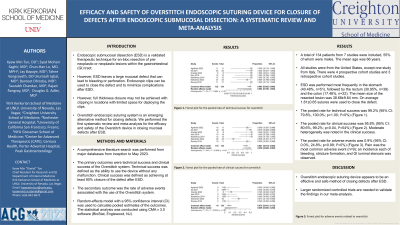Monday Poster Session
Category: Interventional Endoscopy
P2270 - Efficacy and Safety of Overstitch Endoscopic Suturing Device for Closure of Defects After Endoscopic Submucosal Dissection: A Systematic Review and Meta-Analysis
Monday, October 23, 2023
10:30 AM - 4:15 PM PT
Location: Exhibit Hall

Has Audio

Kyaw Min Tun, DO
Kirk Kerkorian School of Medicine at UNLV
Las Vegas, NV
Presenting Author(s)
Kyaw Min Tun, DO1, Syed Mohsin Saghir, MD2, Chun-Han Lo, MD, MPH1, Jay Bapaye, MBBS, MD3, Tahne Vongsavath, DO4, Humzah Iqbal, MD5, Banreet S. Dhindsa, MD6, Saurabh Chandan, MD, MBBS7, Rajani Rangray, MBBS8, Douglas G. Adler, MD9
1Kirk Kerkorian School of Medicine at UNLV, Las Vegas, NV; 2Creighton University, Omaha, NE; 3Rochester General Hospital, Rochester, NY; 4Kirk Kerkorian School of Medicine, Las Vegas, NV; 5University of California San Francisco, Fresno, Fresno, CA; 6University of Nebraska Medical Center, Omaha, NE; 7Creighton University School of Medicine, Omaha, NE; 8CHI Health Creighton University Medical Center, Omaha, NE; 9Center for Advanced Therapeutic (CATE), Centura Health, Porter Adventist Hospital, Peak Gastroenterology, Denver, CO
Introduction: Endoscopic submucosal dissection (ESD) is a validated therapeutic technique for en-bloc resection of pre-neoplastic or neoplastic lesions within the gastrointestinal (GI) tract. However, ESD leaves a large mucosal defect that can lead to bleeding or perforation. Endoscopic clips can be used to close the defect and to minimize complications after ESD. However, full thickness closure may not be achieved with clipping in locations with limited space for deploying the clips. Overstitch endoscopic suturing system is an emerging alternative method for closing defects. We performed the first systematic review and meta-analysis for the efficacy and safety of the Overstitch device in closing mucosal defects after ESD.
Methods: A comprehensive literature search was performed from major databases from inception to May 2023. The primary outcomes were technical success and clinical success of the Overstitch system. Technical success was defined as the ability to use the device without any malfunction. Clinical success was defined as achieving at least 90% closure of the defect after ESD. The secondary outcome was the rate of adverse events associated with the use of the Overstitch system. Random-effects model with a 95% confidence interval (CI) was used to calculate pooled estimates of the outcomes. The statistical analysis was conducted using CMA v 3.0 software (BioStat, Englewood, NJ).
Results: A total of 134 patients from 7 studies were included, 55% of whom were males. The mean age was 66 years. All studies were from the United States, except one study from Italy. ESD was performed most frequently in the stomach (40.48%, n=51), followed by the rectum (30.95%, n=39) and the colon (17.46%, n=22). The mean size of the resected lesion was 38.68±9.64 mm and 1.81±0.65 sutures were used to close the defect on average. The pooled rates for technical success and clinical success were 99.2% (95% CI: 79.8%, 100.0%; p=1.00; I2=0%) and 95.8% (95% CI: 80.6%, 99.2%; p=0.04, I2=54%), respectively (Figure 1). The pooled rate for adverse events was 0.9% (95% CI: 0.0%, 24.8%; p=0.99; I2=0%). Pain was the most common adverse event (n=9); an incidence each of bleeding, stricture formation, and GI luminal stenosis was also observed. Moderate heterogeneity was noted in the clinical success.
Discussion: Overstitch endoscopic suturing device appears to be an effective and safe method of closing defects after ESD. Larger randomized controlled trials are needed to validate the findings in our meta-analysis.

Disclosures:
Kyaw Min Tun, DO1, Syed Mohsin Saghir, MD2, Chun-Han Lo, MD, MPH1, Jay Bapaye, MBBS, MD3, Tahne Vongsavath, DO4, Humzah Iqbal, MD5, Banreet S. Dhindsa, MD6, Saurabh Chandan, MD, MBBS7, Rajani Rangray, MBBS8, Douglas G. Adler, MD9. P2270 - Efficacy and Safety of Overstitch Endoscopic Suturing Device for Closure of Defects After Endoscopic Submucosal Dissection: A Systematic Review and Meta-Analysis, ACG 2023 Annual Scientific Meeting Abstracts. Vancouver, BC, Canada: American College of Gastroenterology.
1Kirk Kerkorian School of Medicine at UNLV, Las Vegas, NV; 2Creighton University, Omaha, NE; 3Rochester General Hospital, Rochester, NY; 4Kirk Kerkorian School of Medicine, Las Vegas, NV; 5University of California San Francisco, Fresno, Fresno, CA; 6University of Nebraska Medical Center, Omaha, NE; 7Creighton University School of Medicine, Omaha, NE; 8CHI Health Creighton University Medical Center, Omaha, NE; 9Center for Advanced Therapeutic (CATE), Centura Health, Porter Adventist Hospital, Peak Gastroenterology, Denver, CO
Introduction: Endoscopic submucosal dissection (ESD) is a validated therapeutic technique for en-bloc resection of pre-neoplastic or neoplastic lesions within the gastrointestinal (GI) tract. However, ESD leaves a large mucosal defect that can lead to bleeding or perforation. Endoscopic clips can be used to close the defect and to minimize complications after ESD. However, full thickness closure may not be achieved with clipping in locations with limited space for deploying the clips. Overstitch endoscopic suturing system is an emerging alternative method for closing defects. We performed the first systematic review and meta-analysis for the efficacy and safety of the Overstitch device in closing mucosal defects after ESD.
Methods: A comprehensive literature search was performed from major databases from inception to May 2023. The primary outcomes were technical success and clinical success of the Overstitch system. Technical success was defined as the ability to use the device without any malfunction. Clinical success was defined as achieving at least 90% closure of the defect after ESD. The secondary outcome was the rate of adverse events associated with the use of the Overstitch system. Random-effects model with a 95% confidence interval (CI) was used to calculate pooled estimates of the outcomes. The statistical analysis was conducted using CMA v 3.0 software (BioStat, Englewood, NJ).
Results: A total of 134 patients from 7 studies were included, 55% of whom were males. The mean age was 66 years. All studies were from the United States, except one study from Italy. ESD was performed most frequently in the stomach (40.48%, n=51), followed by the rectum (30.95%, n=39) and the colon (17.46%, n=22). The mean size of the resected lesion was 38.68±9.64 mm and 1.81±0.65 sutures were used to close the defect on average. The pooled rates for technical success and clinical success were 99.2% (95% CI: 79.8%, 100.0%; p=1.00; I2=0%) and 95.8% (95% CI: 80.6%, 99.2%; p=0.04, I2=54%), respectively (Figure 1). The pooled rate for adverse events was 0.9% (95% CI: 0.0%, 24.8%; p=0.99; I2=0%). Pain was the most common adverse event (n=9); an incidence each of bleeding, stricture formation, and GI luminal stenosis was also observed. Moderate heterogeneity was noted in the clinical success.
Discussion: Overstitch endoscopic suturing device appears to be an effective and safe method of closing defects after ESD. Larger randomized controlled trials are needed to validate the findings in our meta-analysis.

Figure: Figure 1: Forest plots for the pooled rate of technical success (left) and for the pooled rate of clinical success (right)
Disclosures:
Kyaw Min Tun indicated no relevant financial relationships.
Syed Mohsin Saghir indicated no relevant financial relationships.
Chun-Han Lo indicated no relevant financial relationships.
Jay Bapaye indicated no relevant financial relationships.
Tahne Vongsavath indicated no relevant financial relationships.
Humzah Iqbal indicated no relevant financial relationships.
Banreet Dhindsa indicated no relevant financial relationships.
Saurabh Chandan indicated no relevant financial relationships.
Rajani Rangray indicated no relevant financial relationships.
Douglas Adler indicated no relevant financial relationships.
Kyaw Min Tun, DO1, Syed Mohsin Saghir, MD2, Chun-Han Lo, MD, MPH1, Jay Bapaye, MBBS, MD3, Tahne Vongsavath, DO4, Humzah Iqbal, MD5, Banreet S. Dhindsa, MD6, Saurabh Chandan, MD, MBBS7, Rajani Rangray, MBBS8, Douglas G. Adler, MD9. P2270 - Efficacy and Safety of Overstitch Endoscopic Suturing Device for Closure of Defects After Endoscopic Submucosal Dissection: A Systematic Review and Meta-Analysis, ACG 2023 Annual Scientific Meeting Abstracts. Vancouver, BC, Canada: American College of Gastroenterology.
